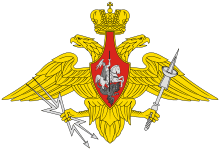Russian Space Forces
| Russian Space Forces | |
|---|---|
 Flag of the Russian Space Forces | |
| Active |
1992 – 1997 2001 – 2011 1 August 2015 – present |
| Country | Russia |
| Allegiance | Ministry of Defence |
| Type | Space force |
| Role | Space warfare |
| Size | 150,000 personnel (2014)[1] |
| Anniversaries | 4 October (Space Forces Day) |
| Commanders | |
| Current commander | Lt. Gen. Aleksandr Golovko |
| Armed Forces of the Russian Federation |
|---|
.svg.png) |
| Services (vid) |
| Independent troops (rod) |
| Other troops |
|
| Ranks of the Russian Military |
| Uniforms of the Russian Military |
| History of the Russian military |
The Russian Space Forces (Russian: Космические войска России, tr. Kosmicheskie Voyska Rossii) are a branch of the Russian Aerospace Forces, that provides aerospace warning, air sovereignty, and protection for Russia. Having been reestablished following the 1 August 2015 merger between the Russian Air Force and the Russian Aerospace Defence Forces after a 2011 dissolving of the branch. The Russian Space Forces were originally formed on the 10 August 1992 and the creation of the Russian Armed Forces.[2] The organisation shared control of the Baikonur Cosmodrome with the Russian Federal Space Agency. It also operated the Plesetsk and the Svobodny Cosmodromes. However the Russian Space Forces were dissolved in July 1997 and incorporated into the Strategic Missile Troops.[3]
The Russian Space Forces were once again reformed as an independent troop on the 1 June 2001 under a military reorganisation. However, by December 2011, it was dissolved once again and this time replaced by the Russian Aerospace Defence Forces.[4]
On 1 August 2015, the Russian Air Force and the Russian Aerospace Defence Forces were merged to form the Russian Aerospace Forces.[5][6] The Russian Space Forces were reestablished as a result, and are now one of three sub-branches of the new armed force.[7]
History
In 1967 the Troops of Anti-Missile and Anti-Space Defence was formed (Russian: войска противоракетной и противокосмической обороны [ПРО и ПКО], tr. Voyska Protivoraketnoy i Protivokosmicheskoy Oborony [PRO i PKO]) under General-Lieutenant of the Artillery Yu. Votintsev.[8] They were reorganised as the Ministry of Defence Space Units in 1982. In 1991 the Soviet Union was broken up. The Armed Forces of the Russian Federation were established on May 7, 1992, enabling the creation of Russian Space Forces later that year on August 10.
In July 1997 the Space Force was dissolved as a separate service arm and incorporated to the Strategic Rocket Forces along with the Space Missile Defence Forces (Russian: Ракетно-космическая оборона), which previously were part of the Soviet Air Defence Forces. In the view of some experts, this was a mistake that prevented the Russian military from developing space-based capabilities. Russian Public TV said of the merger:[3]
However, slightly over three years ago, it appeared to some-one, that, with a view to saving funds, it would be more sensible to strip the Military Space Forces of their independence and subordinate them to the Strategic Missile Troops -which has been done. In just the same way the country's air defence forces were made subordinate to the air force.
Under the slogan of "optimizing", but, essentially, reducing the officer corps of the armed forces, the Military Space Forces were simply merged with the Strategic Missile Troops. In this way the missilemen command remained in their places virtually in full and almost the entire elite of military engineers were dispersed from the space forces. The military base, too, was destroyed. In the building of the Military Space Forces headquarters on Kaluga Square [Kaluzhskaya ploshchad], the very expensive fibre optic cable necessary for communicating with space facilities was ripped out. Afterwards, this decision was deemed to have been erroneous.
The Russian Space Forces were officially reborn on June 1, 2001 as an independent section of the Russian military. They regained independence under one of the many military reorganisation plans of the mid-late 1990s. Colonel General Anatoly Perminov was appointed to lead the new Space Forces.[9] He was succeeded by General Vladimir Popovkin in 2004 and General Oleg Ostapenko in 2008 until dissolution in 2011.[10]
On the 1 August 2015, the Space Forces were reestablished as part of the Russian Aerospace Forces..
Structure
The main tasks of the Russian Space Forces are informing the higher political leaders and military commanders of missile attacks as soon as possible, ballistic missile defence, and the creation, deployment, maintenance and control of in-orbit space vehicles, like the new Persona reconnaissance satellite. For example, the Space Forces operate the GLONASS global positioning system; commander of the Space Forces Colonel General Vladimir Popovkin said in January 2006 that 18 GLONASS satellites would be in orbit by 2008. In October 2010 the system became fully operational.
Formations of the Space Forces included the 3rd Missile-Space Defence Army, and a Division of Warning of Missile Attack, both with their headquarters at Solnechnogorsk near Moscow. Installations and assets include the Hantsavichy Radar Station in Belarus, along with a number of other large warning radars, and the A-135 anti-ballistic missile system which protects Moscow and the Peresvet anti-air laser combat system which protects strategic missiles.[11][12][13]
There is also an optical tracking facility, the Okno (Window) complex near the town of Nurek in central Tajikistan that is intended to monitor objects in space. The Okno is capable of tracking objects 40,000 kilometers (25,000 mi) from Earth, the space forces said when it °was put on duty in 2002. The facility involves telescope-like equipment housed in several large spheres, similar to the U.S. GEODSS system.[14]

3rd Missile-Space Defence Army, status in 2002
- 1st Division of Warning of Missile Attack – HQ: Solnechnogorsk[15][16]
- East Oko Headquarters – Komsomolsk-na-Amure (Pivan-1)
- West Oko Headquarters – Kurilovo (Serpukhov-15)
- Radar Site (ORTU) RO-1 Olenegorsk – Radar Dnepr (Hen House)
- Radar Site RO-5 – Beregovo, Ukraine – Radar Dnepr (Hen House, under Ukrainian control, all Ukrainian personnel)[17]
- Radar Site RO-4 – Sevastopol area, Russia – Radar Dnepr (Hen House, under Russian control, all Russian personnel)
- Radar Site OS-2 – Balkhash, Kazakhstan – Radar Dnepr (Hen House)
- Radar Site OS-1 – Mishelevka, Irkutsk – Radar Dnepr (Hen House)
- Radar Site RO-30 – Pechora – Radar Daryal (Pechora)
- Radar Site RO-7 – Gabala, Azerbaijan – Radar Daryal (Pechora)
- Radar Site Gantcevichi, Belarus – Radar Volga
- Radar Site – Komsomolsk-na-Amure – Radar Duga-2 (Steel Yard)
- Radar Site Sofrino, in common with PRO – Radar Don-2 (Pill Box)
- 9th Division of Defence Against Missiles – HQ: Sofrino [18] (A-135 anti-ballistic missile system)
- Missile Site – Novopetrovska – 51Т6
- Missile Site – Klin – 51Т6
- Missile Site – Shodna – 53Т6
- Missile Site – Turakovo (Aleksandrov) – 51Т6
- Missile Site – Korolev – 53Т6
- Missile Site – Litkarino – 53Т6
- Missile Site – Vnukovo – 53Т6
- Missile Site – Kolodkino – 51Т6
- Radar Site – Sofrino – Radar Don-2N (Pill Box)
- Radar Site – Stremilovo (Chekhov-7) – Radar Dunay-3U (Cat House)
- Radar Site – Kubinka – Radar Dunay-M (Dog House)
- 45th Division of Space Control – HQ: Noginsk area
- Optical Electronic Complex Okno (Window) – Object 7680 – Nurek, Tajikistan
- Laser Radar Krona ОРТУ – Zelenchukskaya, Cherkessk Area
- Also are used Radar Site Sofrino, Balkhash, Mishelevka
2018
- 15th Aerospace Forces Army
Commanders
| Name | Start | End | Notable offices held before or after | |
|---|---|---|---|---|
| 1 | General Kerim Kerimov | 1964 | 1965 | |
| 2 | General Andrei Karas | 1965 | 1979 | |
| 3 | General Aleksandr Maksimov | 1979 | 1989 | |
| 4 | General Vladimir Ivanov | 1989 | 1996 | |
| 5 | General Anatoly Perminov | 2001 | 2004 | Director of Federal Space Agency (2004—2011) |
| 6 | General Vladimir Popovkin | 2004 | 2008 | Head of Roscosmos (2011–2013) |
| 7 | General Oleg Ostapenko | 2008 | 2011 | Director of Russian Federal Space Agency (2013–2015) |
| 8 | General Vladimir Ivanov | 2012 | 2012 | |
| 9 | General Aleksandr Golovko | 2015 | Commander of Russian Aerospace Defence Forces (2011–2015) |
See also
References
- ↑ International Institute for Strategic Studies: The Military Balance 2014, p.181
- ↑ Lindborg, Christina (1997). "VKS". World Space Guide. Federation of American Scientists. Archived from the original on November 23, 2011. Retrieved March 24, 2012.
- 1 2 Russian Public TV (ORT), Moscow, in Russian 1700 gmt March 28, 2001, via BBC Summary of World Broadcasts
- ↑ "Russia's Aerospace Defense Forces go on duty to stave off missile threats". RIA Novosti. December 1, 2011. Retrieved December 25, 2011.
- ↑ Aerospace Forces
- ↑ http://ria.ru/defense_safety/20150803/1160022393.html
- ↑ Russia creates new Aerospace Force service branch, janes.com, 4 August 2015
- ↑ "4 октября – День военно-космических сил России" [October 4 – Day of Military Space Forces in Russia] (in Russian). Prazdnuem. n.d.
- ↑ ITAR-Tass news agency, via http://www.flug-revue.rotor.com/FRNews1/FRNews01/FR010603.htm Archived August 17, 2007, at the Wayback Machine.
- ↑ "Oleg Ostapenko". Ministry of Defence of the Russian Federation. n.d. Retrieved February 29, 2012.
- ↑ http://tass.com/defense/1014121
- ↑ https://defence-blog.com/army/russian-secret-laser-complex-spotted-near-teykovo-icbm-base.html
- ↑ https://www.youtube.com/watch?v=vvcsBRj8vSM
- ↑ "Sourcebook on the Okno (в/ч 52168), Krona (в/ч 20096) and Krona-N (в/ч 20776) Space Surveillance Sites" (PDF). Federation of American Scientists. December 30, 2008. Retrieved 2012-03-12.
- ↑ Kommersant-Vlast, May 14, 2002, www.brinkster.net
- ↑ Podvig, Pavel (2002). "History and the Current Status of the Russian Early-Warning System" (PDF). Science and Global Security. 10: 21–60. doi:10.1080/08929880212328. ISSN 0892-9882. Archived from the original (pdf) on March 15, 2012.
- ↑ Petrov, Nikita (February 5, 2008). "Kiev Radar Row Set to Inflame Tensions Part One". Space Mart/RIA Novosti. Retrieved March 24, 2012.
- ↑ "9 ДИВИЗИЯ ПРОТИВОРАКЕТНОЙ ОБОРОНЫ" [9 DIVISION MISSILE DEFENCE] (in Russian). Warfare.Ru. n.d. Retrieved 2012-03-24.
- ↑ "Space Forces". Ministry of Defence of the Russian Federation. Retrieved 23 July 2018.
External links
| Wikimedia Commons has media related to Russian Space Forces. |